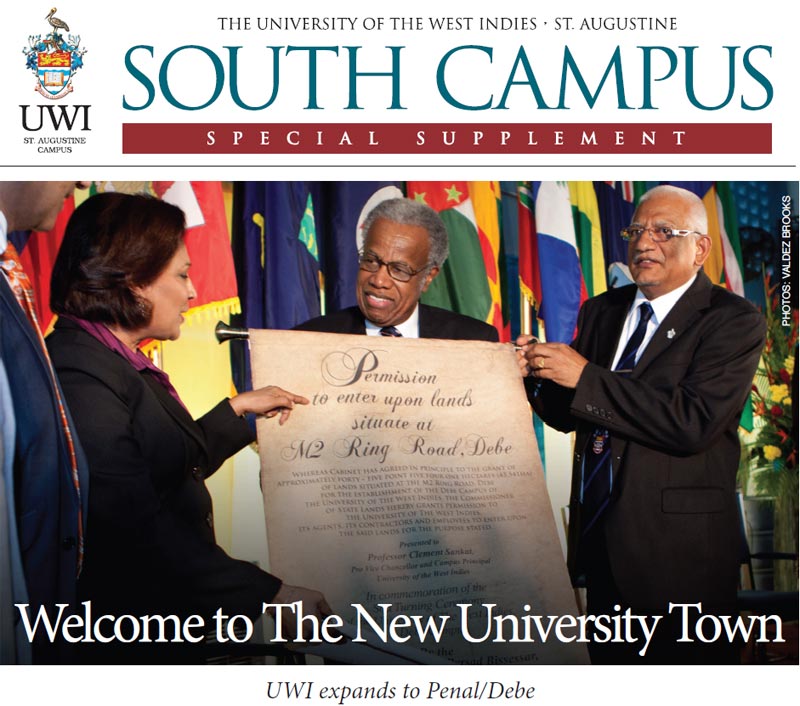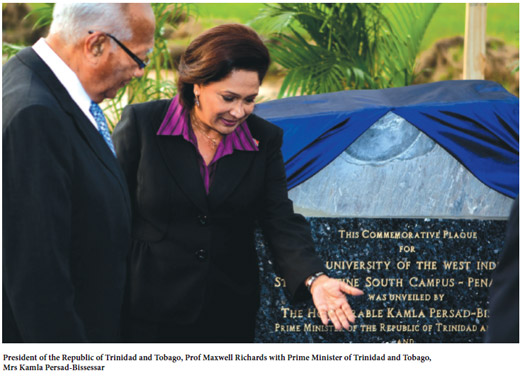 |
 |
 |
|
February/March 2011
|
By Anna Walcott-Hardy “A University town” that will be a key driver of prosperity is the vision Prime Minister of Trinidad and Tobago, Mrs Kamla Persad-Bissessar has for Debe. Describing herself as a “quintessential UWI person,” having been both student and lecturer at all three Main Campuses at Jamaica, Barbados and Trinidad, she seemed pleased with the plans for expansion of access to tertiary education to the South. The Prime Minister was speaking at the ceremony for the dedication of lands and unveiling of a commemorative plaque for The University of the West Indies St. Augustine - South Campus Penal/Debe on a humid afternoon on Thursday 24 February at the Debe High School. Bounded by Papourie Road on the East, San Fernando Erin Road on the West and the M2 Ring Road on the South, the Campus lands resemble a Hinkson watercolour, awash with warm greens, burnt umber and ochre. The rolling hills of the former Picton Estate – still planted with cane – recall a time when sugar was king. In fact, the Usine St Madeleine factory is located not too far from the site, and if you drive past the high school you are at the popular Debe “doubles” stretch, with the historically rich, Gandhi village, a few miles away. In October 2010, Minister of Science Technology and Tertiary Education, Fazal Karim, put forward a Cabinet note on the allocation of lands for a south campus for The UWI, the proposal looked at a 100-acre parcel of land in the vicinity of Debe. On October 14, 2010 Cabinet agreed. An allocation of $TT2 million was included in the National Budget to support the development of the Campus. Speaking at the Ceremony, before 1,000 guests, including the President of the Republic of Trinidad and Tobago, Prof Maxwell Richards, The UWI St Augustine Campus Principal Professor Clement Sankat focused on development of UWI to the South of Trinidad as well as the expansion of offerings in Tobago. He underscored the benefits the new Campus extension would bring to the people of the “Southland,” explaining that empirical evidence had supported the need for expansion of the St. Augustine Campus.
“Despite the increasing competitive environment in which we are placed, statistics on applications for entry into UWI have also demonstrated a robust demand over the years and the St. Augustine Campus was only able to offer places to 70 per cent of its highly qualified applicants in 2010/2011,” Pro Vice Chancellor Sankat explained. “In a 2007 planning report on the findings of a national survey to measure public perceptions of The University of the West Indies n Trinidad and Tobago, at least 75 per cent of the persons surveyed agreed that The University of the West Indies should establish a Campus in Tobago. Further, 67 per cent believed that the UWI should establish a Campus in South Trinidad,” he added. But what do the people of the area really think about the new Campus? With 38 feeder schools in the counties of St Patrick, Victoria and the districts of Rio Claro and Mayaro, high-performing institutions with students and teachers that continue to look to UWI for higher education, interviews were easy to come by and the interviewees were politely frank with their answers. Niala Seudatsingh, a 17-year-old student of Parvati Hindu College, is looking forward to the opening of Safety Officer at Debe High School, Mustapha Mohammed has two daughters enrolled at The UWI. Although he spoke warmly of the financial benefits of the new Campus for southerners, he added that currently there are rising associated expenses for St Augustine students: rent, food and travel. “One you’re looking at in terms of statistics…in terms of physical arrangements…and a sense of security for the public, the community,” were some of the advantages Fyzabad Secondary High School Principal, Troy Jebodhsingh, also a UWI graduate (1992) listed. Debe High School Principal, Romeo Gunness, knows first-hand the transportation and scheduling issues associated with studying at UWI and living in Penal, having gained an undergraduate degree in 1990 from UWI and a Master’s degree in Education in 1997. “It was stressful, but rewarding in the end…opportunities like those make you value opportunities like these… [the South Campus] it’s excellent motivation for our students, it’s a physical presence to work towards.” Acting Vice-Principal of Debe High School another UWI graduate, Arlene Dwarika, welcomed the launch of the new Campus. She said that the UWI Campus, which will be located next to the 10-year-old Debe High School (officially opened by the current Prime Minister when she was then Minister of Education), has a sixth form class of about 40 students. Each year, approximately 15 enroll at UWI and about 20 attend the University of Trinidad and Tobago. “The availability of land and Government land is an issue: San Fernando is totally cluttered…but this [South Campus] is a very strategic location…it is a wonderful idea and just ten to fifteen minutes from San Fernando,” Dwarika explained. However, having gained both undergraduate and postgraduate degrees from UWI, she recalled that traveling to and from the Campus was a challenge. She also recommends having a wide range of programme offerings at the South Campus and not those solely confined to Law. In fact, the Faculty of Law is just one of the six faculties that will be represented at the Campus: Engineering, Science and Agriculture, Humanities and Education, Social Sciences and Medicine will all become present. During his presentation, the Campus Principal noted that UWI was aware of these needs, stating that another empirical study reflected the job opportunities in the south of the island, which, based on demand, included Management Studies, Psychology, Economics, Law, Social Work, Information Technology, Nursing, Finance, Accounting, Engineering and those in the manufacturing and industry based fields. There are plans for technological advances also. “The Campus will boast modern technology which would grant students access to a variety of learning methods, databases, and collaborative tools. Furthermore, it is our intention for the Campus itself to be a beacon of social awareness and innovation, and to be a Green Campus, which is energy and resource efficient. My hope is that this Campus can be the first in Trinidad and Tobago which is at least partially powered by solar energy,” Minister Fazal Karim stated. The Minister added that the Campus will be a southern academic hub catering for an outflow of 4,100 qualified students from 38 secondary schools in the Southern basin. Universities have continued to evolve from the ancient Greek/Roman model of master/student to the apprenticeship model of the Renaissance, to the virtual school, but according to UWI Chancellor, Sir George Alleyne, at UWI there is a blend of both: a physical locus as the centre of dissemination and a locus for human interaction. The South Campus will promote both.
|



 the new Campus in 2013; she explained why: her mother spends about two hours in traffic every day to drive her sister to classes at UWI St Augustine.
the new Campus in 2013; she explained why: her mother spends about two hours in traffic every day to drive her sister to classes at UWI St Augustine.